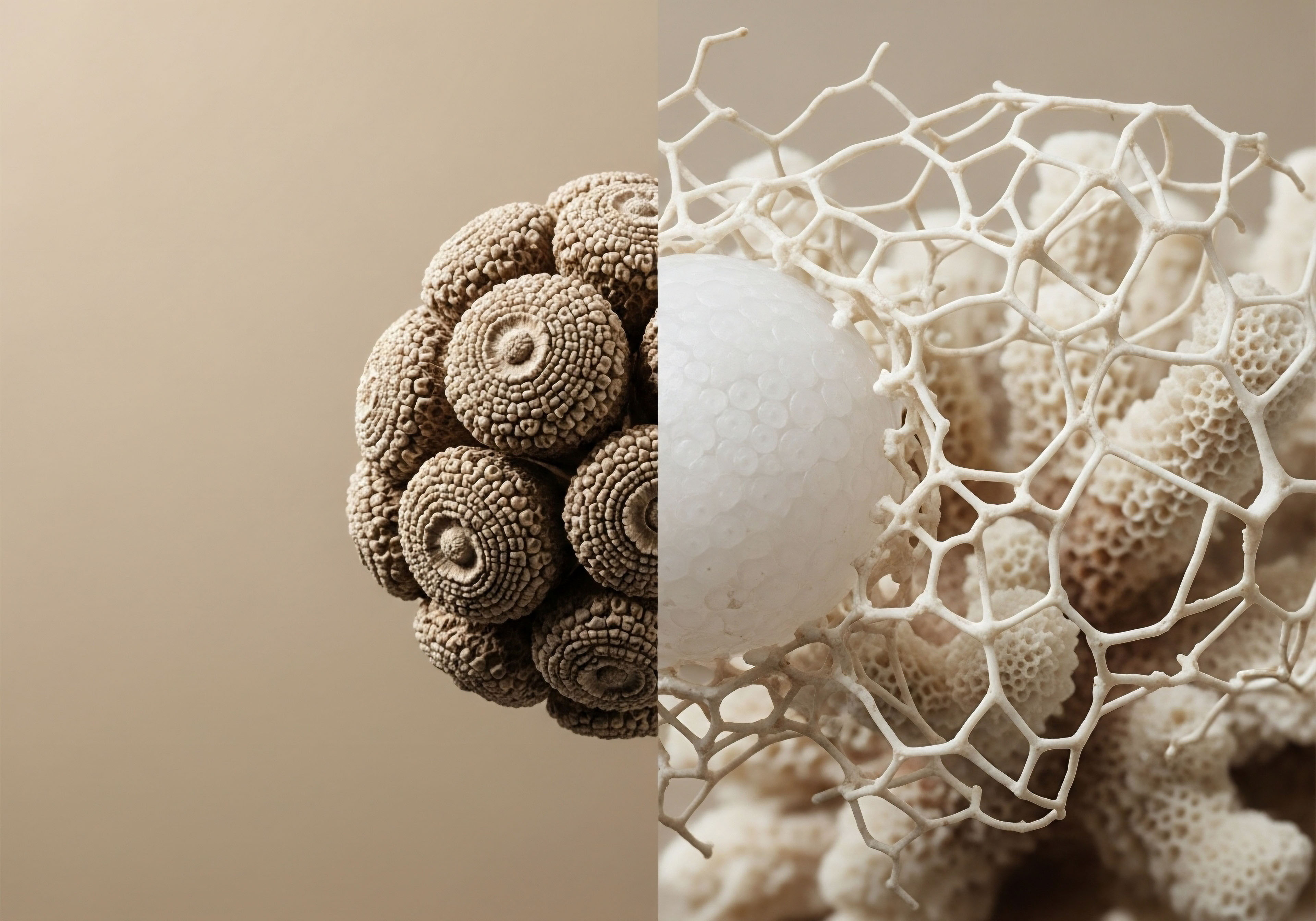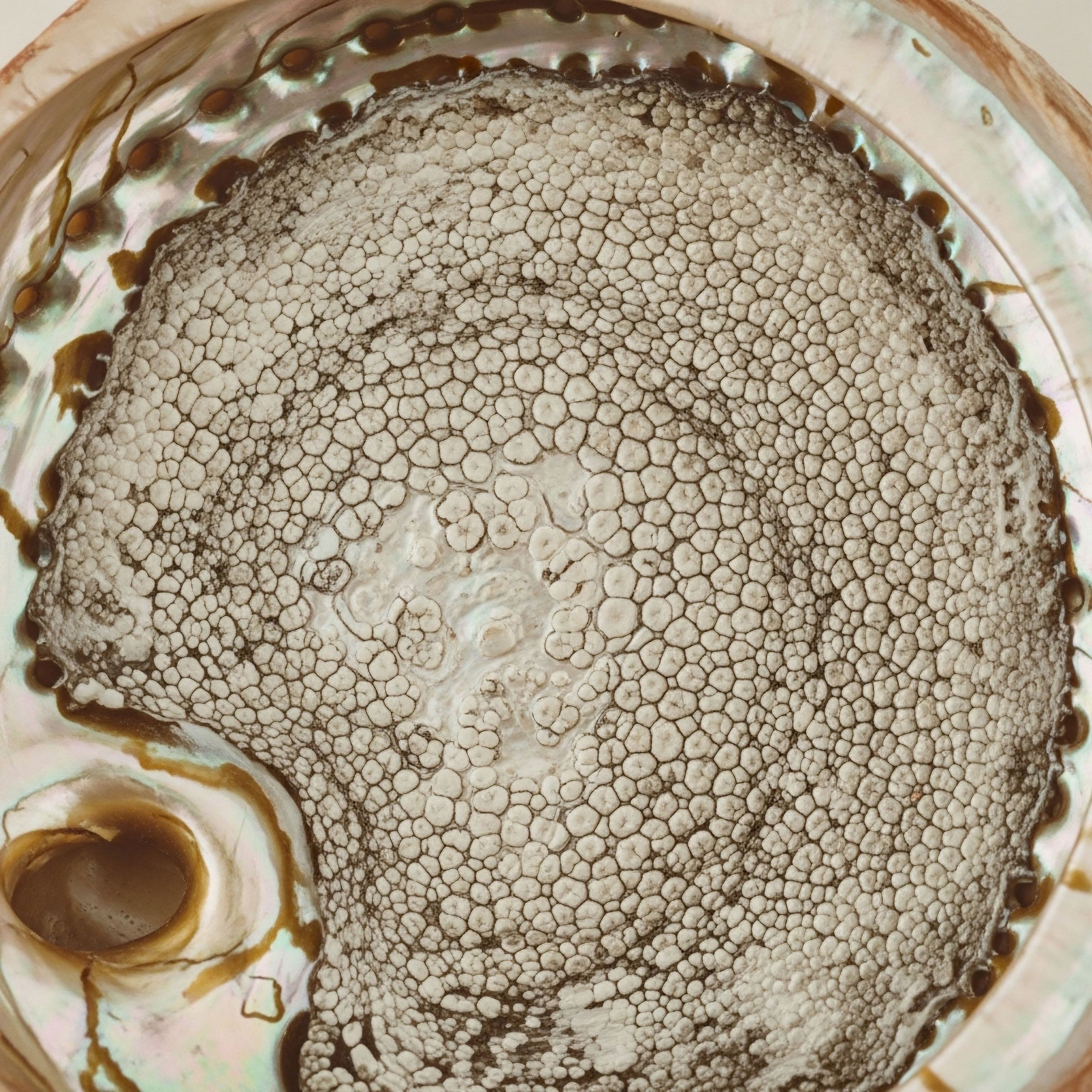

Fundamentals
You have likely noticed subtle shifts in the mirror, a change in the fullness of your cheeks or the firmness of your jawline that feels disconnected from your chronological age or lifestyle. This observation is a valid starting point for a deeper conversation about your body’s internal environment. The question of whether hormonal optimization Meaning ∞ Hormonal Optimization is a clinical strategy for achieving physiological balance and optimal function within an individual’s endocrine system, extending beyond mere reference range normalcy. can refine the natural contours of your face is insightful.
It moves the conversation from surface-level treatments to the foundational systems that govern your cellular health. The answer lies in understanding that your skin and the underlying facial architecture are profoundly responsive to the body’s primary signaling molecules, your hormones.
Think of hormones like estrogen and testosterone as the body’s internal communication network, carrying vital instructions to nearly every cell. In the context of facial structure, these hormones are the architects and maintenance crew for your skin’s integrity. They direct specialized cells, known as fibroblasts, to produce collagen and elastin.
Collagen provides the essential scaffolding that gives your skin its firmness and structure, while elastin allows it to return to its shape. When these hormonal signals are robust and consistent, your skin maintains its youthful density and resilience.

The Architecture of Hormonal Influence
The gradual decline in key hormones, a process that accelerates for women during perimenopause Meaning ∞ Perimenopause defines the physiological transition preceding menopause, marked by irregular menstrual cycles and fluctuating ovarian hormone production. and for men during andropause, represents a slowing of this internal communication. With fewer hormonal messages arriving, fibroblast activity Meaning ∞ Fibroblast activity represents the dynamic cellular processes undertaken by fibroblasts, the primary cells responsible for synthesizing and remodeling the extracellular matrix (ECM) within connective tissues throughout the body. decreases. The collagen scaffolding begins to thin, and the elastin fibers lose some of their spring. This internal shift manifests externally as increased skin laxity and fine lines.
Simultaneously, hormones like estrogen play a significant role in maintaining skin hydration by supporting the production of hyaluronic acid, a molecule that binds water within the dermis. A reduction in estrogen leads to less hydrated, thinner-looking skin.
Hormones act as fundamental regulators of the skin’s structural proteins and hydration levels.
Furthermore, these same hormones influence the distribution and volume of subcutaneous fat pads that contribute to the soft, full contours of the face. As hormonal levels change, these fat pads can shrink or shift, leading to a loss of volume in the mid-face and a heavier appearance in the lower face and jowls. A biochemical recalibration protocol is designed to replenish these essential signals, restoring the instructions for collagen production, hydration, and structural maintenance. By addressing the root cause of these changes at a systemic level, it is possible to support the very framework that defines your facial contour.


Intermediate
To comprehend how hormonal protocols can refine facial contours, we must examine the specific actions of key hormones on the skin’s cellular machinery. The aesthetic changes associated with hormonal decline are direct consequences of altered biological processes. Hormonal optimization seeks to correct these processes by restoring biochemical signals, leading to tangible improvements in skin quality and structure. Estrogen, in particular, is a master regulator of dermal health.
It binds to specific estrogen receptors Meaning ∞ Estrogen Receptors are specialized protein molecules within cells, serving as primary binding sites for estrogen hormones. located on fibroblast cells, directly stimulating the synthesis of Type I and Type III procollagen, the precursors to the skin’s main structural proteins. This targeted action thickens the dermal layer, improving its resilience and appearance.

Protocols for Facial Architecture Support
Clinical protocols are designed to address these deficiencies with precision, recognizing the distinct needs of both men and women. The goal is a systemic recalibration that produces visible benefits in tissues like the skin.

Female Hormone Balance
For women in perimenopause or post-menopause, therapy often involves estradiol, a bioidentical form of estrogen. The administration of estradiol has been shown to increase skin thickness, boost hyaluronic acid Meaning ∞ Hyaluronic Acid is a naturally occurring anionic glycosaminoglycan, a polysaccharide widely distributed throughout connective, epithelial, and neural tissues. levels for better hydration, and improve the skin’s elastic properties. In many protocols, low-dose Testosterone Cypionate is also included.
While known for its effects on libido and energy, testosterone contributes to skin health by supporting sebum production, which protects the skin barrier, and by maintaining the tone of underlying facial muscles. This combination provides a comprehensive approach to rebuilding the skin’s foundational elements.
- Estradiol ∞ Directly stimulates fibroblasts to produce new collagen, enhancing skin thickness and firmness. It also improves the skin’s ability to retain water, reducing the appearance of fine, dry lines.
- Testosterone (low-dose) ∞ Contributes to skin’s resilience and the structural integrity of underlying facial muscles, which provides a supportive base for the skin.
- Progesterone ∞ Often used in conjunction with estrogen, progesterone can influence skin elasticity and circulation, further contributing to a healthy appearance.

Male Hormone Optimization
For men experiencing andropause, Testosterone Replacement Therapy Meaning ∞ Testosterone Replacement Therapy (TRT) is a medical treatment for individuals with clinical hypogonadism. (TRT) using Testosterone Cypionate is the standard protocol. Testosterone has a distinct and powerful effect on skin. It significantly influences dermal thickness and collagen production.
Men on optimized testosterone protocols often notice that their skin becomes firmer and more resilient. This therapy, often supported by agents like Gonadorelin to maintain systemic balance, ensures that the body’s largest organ receives the hormonal signals needed for robust health, which translates into a more defined facial appearance.
Specific hormonal protocols for men and women are designed to restore the cellular activities responsible for maintaining skin’s structural integrity.
The table below outlines the distinct and complementary roles of estrogen and testosterone in influencing the key characteristics of facial skin.
| Facial Characteristic | Primary Influence of Estrogen | Primary Influence of Testosterone |
|---|---|---|
| Collagen Production | Strongly promotes Type I & III collagen synthesis, increasing dermal thickness. | Supports collagen density and skin thickness. |
| Skin Elasticity | Improves skin’s elastic recoil by supporting elastin fibers. | Contributes to overall skin firmness and tone. |
| Hydration (Water Content) | Significantly increases hyaluronic acid production, leading to better dermal hydration. | Has a lesser, indirect effect on hydration. |
| Facial Fat Distribution | Helps maintain subcutaneous fat in the cheeks and periorbital area. | Influences muscle mass and definition, which shapes facial contours. |
| Sebum Production | Generally decreases oil gland production. | Increases sebum production, which contributes to the skin’s protective barrier. |
Academic
A sophisticated analysis of hormonal influence on facial aesthetics requires moving beyond dermal-level effects to a systems-biology perspective. The visible changes in facial contour are external manifestations of systemic endocrine shifts, primarily governed by the Hypothalamic-Pituitary-Gonadal (HPG) axis. The efficacy of hormonal therapies in mitigating these changes is closely linked to a concept known as the “critical window hypothesis.” This hypothesis posits that the timing of intervention is a paramount determinant of long-term outcomes, particularly concerning the preservation of connective tissue and bone—the two pillars of facial architecture.

The Critical Window for Structural Preservation
Research, including re-analyses of data from the Women’s Health Initiative, indicates that initiating hormonal therapy early in menopause (typically within the first 10 years and before age 60) yields the most significant benefits for skin and bone. Women who begin therapy during this critical window Meaning ∞ A critical window denotes a finite period in biological development or physiological adaptation when an organism or specific system demonstrates heightened sensitivity to particular internal or external stimuli. show greater preservation of collagen, skin elasticity, and hydration compared to those who start later. This is because the cellular machinery, such as the fibroblasts and osteoblasts, are still highly responsive to hormonal signals.
Delaying intervention may result in irreversible structural losses that are more difficult to address. From a mechanistic standpoint, early estrogen replacement maintains the expression of transforming growth factor-beta 1 (TGF-β1), a cytokine essential for stimulating collagen synthesis Meaning ∞ Collagen synthesis is the precise biological process by which the body constructs collagen proteins, its most abundant structural components. and regulating tissue repair, preventing the accelerated degradation seen in an estrogen-deficient state.

How Does HRT Affect Facial Bone Structure?
A crucial, often overlooked, component of facial contouring is the underlying skeletal framework. Estrogen deficiency is a primary driver of osteoporosis, a condition of systemic bone loss. This process also affects the craniofacial skeleton. Age-related bone resorption Meaning ∞ Bone resorption refers to the physiological process by which osteoclasts, specialized bone cells, break down old or damaged bone tissue. leads to measurable changes in the mandible (jawbone), maxilla (upper jaw), and orbital rims.
A slight retrusion of the jaw or widening of the eye sockets alters the overlying soft tissue drape, contributing to jowling and a sunken appearance. Because hormonal optimization protocols are highly effective at preserving bone mineral density systemically, they concurrently protect this facial scaffolding. By mitigating bone loss, HRT helps maintain the fundamental structure upon which the skin and fat pads rest, preserving the natural contours of the face from the inside out.
The timing of hormonal intervention is a critical factor in preserving both the skin’s collagen matrix and the underlying facial bone structure.
The table below illustrates the differing outcomes based on the timing of hormonal therapy initiation, as suggested by the critical window hypothesis.
| Biological System | Intervention During Critical Window (Early Menopause) | Intervention After Critical Window (Late Menopause) |
|---|---|---|
| Dermal Collagen Matrix | Significant preservation of collagen density and skin thickness. Fibroblasts remain highly responsive. | Limited ability to restore lost collagen; effects are less pronounced. |
| Skin Elasticity | Maintains skin’s elastic properties, preventing significant laxity. | Modest improvements; unable to fully reverse established elastosis. |
| Facial Bone Density | Effectively prevents accelerated bone resorption of the mandible and maxilla. | Slows further bone loss but cannot fully restore lost bone volume. |
| Overall Facial Contour | Preserves youthful facial volume and definition by supporting both soft tissue and skeletal structures. | Offers some improvement in skin quality but has less impact on foundational contour changes. |

Biomarkers of Hormonal Efficacy
The impact of these therapies can be tracked through specific biological markers that reflect connective tissue metabolism. Monitoring these provides objective data on the restoration of cellular function.
- Serum Procollagen Type I C-terminal Propeptide (PICP) ∞ An indicator of active Type I collagen synthesis, which is expected to increase with effective estrogen therapy.
- Urinary N-telopeptide (NTx) ∞ A marker for bone resorption. A decrease in NTx levels indicates that hormonal therapy is successfully reducing the rate of bone breakdown.
- Hyaluronic Acid (HA) Levels ∞ While not always a standard clinical measure, research shows estrogen’s role in upregulating HA, which can be correlated with improved skin hydration.
Ultimately, viewing facial aging through the lens of endocrinology and systems biology reveals that improving facial contour is an achievable outcome of well-timed, personalized hormonal optimization. The approach addresses the foundational drivers of structural change, offering benefits that are integrated and sustained.
References
- Wolff, E. F. Narayan, D. & Taylor, H. S. (2005). Long-term effects of hormone therapy on skin rigidity and wrinkles. Fertility and Sterility, 84(2), 285–288.
- Brincat, M. & Pollacco, J. (2024). Menopause and the effects of Hormone Replacement Therapy on skin aging ∞ A Short Review. GREM – Gynecological and Reproductive Endocrinology & Metabolism, 5(1), 34-37.
- Castelo-Branco, C. Duran, M. & Gonzalez-Merlo, J. (1992). Skin collagen changes related to age and hormone replacement therapy. Maturitas, 15(2), 113-119.
- Pearce, T. (2025). Menopausal Facial Changes ∞ HRT Benefits in Aesthetic Practice. Dr Tim Pearce eLearning Blog.
- Perman, S. (2025). HRT for Skin ∞ Embracing Aging with Confidence. Winona.
Reflection
Understanding the intricate relationship between your endocrine system and your physical form is the first step in a proactive health journey. The information presented here serves as a map, illustrating the biological pathways that connect your internal hormonal environment to the external contours of your face. Your unique physiology, history, and goals will define your path forward.
How might viewing your body as an integrated system, where cellular health dictates aesthetic outcomes, shape your approach to long-term wellness? This knowledge empowers you to ask more precise questions and seek personalized strategies that align with your body’s specific needs, creating a partnership aimed at restoring function and vitality from the inside out.








